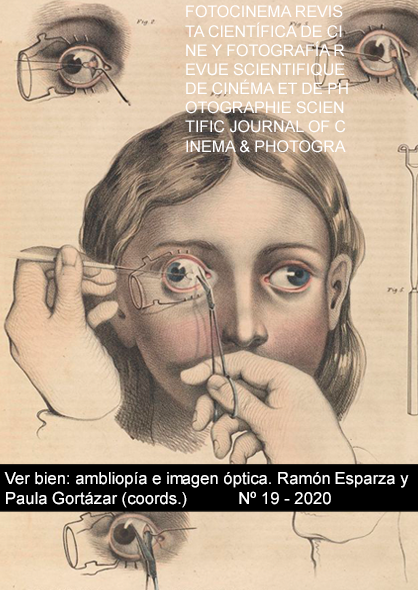Ambliopía
DOI:
https://doi.org/10.24310/Fotocinema.2019.v2i19.6676Keywords:
fotografia, ambliopíaAbstract
Pero como todo lo que concierne a la visión, la ambliopía es un término complejo, al menos de delimitar, porque inmediatamente nos lleva a una pregunta cuya respuesta tiene, necesariamente, un carácter histórico ¿qué es ver bien? Estoy escribiendo este texto viéndolo en un monitor cuya resolución es muy superior al de aquella televisión analógica que conocimos de niños. Mayor resolución implica mayor cantidad de información y por lo tanto mayor trabajo fisiológico y sicológico. Lo mismo podríamos decir de la comparación de aquellas primeras imágenes en huecograbado y los sistemas de impresión actuales. La reproducción de los detalles y las variaciones de tono es, en algunos casos, superior a la que es capaz de detectar el ojo humano. ¿Sentirían los miopes de hoy en día la necesidad de utilizar lentes correctoras hace un par de siglos?
Downloads
Metrics
References
Renger-Patzsch, A. (1989). Aims. En Phillips, C. Photography in the modern era. New York: Aperture.
Smith, P. (2013). Cezanne’s “Primitive” Perspective, or the “View from Everywhere”. Art Bulletin. Volumen XCV, 1, marzo.
Wade, N. J. (1998). A natural history of vision. Cambridge: The MIT Press.
Downloads
Published
How to Cite
Issue
Section
License
All contents published in Fotocinema Revista científica de cine y fotografía are protected under the Creative Commons Attribution-NonCommercial-ShareAlike 4.0 International (CC BY-NC-SA 4.0) license. All about this license is available in the following link: <http://creativecommons.org/licenses/by-nc-sa/4.0>
Users can copy, use, redistribute, share and exhibit publicly as long as:
- The original source and authorship of the material are cited (Journal, Publisher and URL of the work).
- It is not used for comercial purposes.
- The existence of the license and its especifications are mentioned.
There are two sets of authors’ rights: moral and property rights. Moral rights are perpetual prerogatives, unrenounceable, not-transferable, unalienable, imprescriptible and inembargable. According to authors’ rights legislation, Fotocinema. Revista científica de cine y fotografía recognizes and respects authors moral rights, as well as the ownership of property rights, which will be transferred to University of Malaga in open access. The property rights are referred to the benefits that are gained by the use or the dissemination of works. Fotocinema. Revista científica de cine y fotografía is published in an open access form and it is exclusively licenced by any means for doing or authorising distribution, dissemination, reproduction, , adaptation, translation or arrangement of works.
Authors are responsable for obtaining the necessary permission to use copyrighted images.













13.png)



